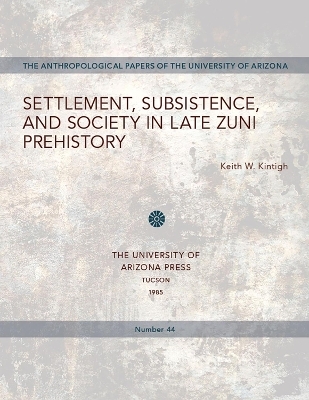
Settlement, Subsistence, and Society in Late Zuni Prehistory
Seiten
2015
University of Arizona Press (Verlag)
978-0-8165-0831-0 (ISBN)
University of Arizona Press (Verlag)
978-0-8165-0831-0 (ISBN)
Demonstrates how changing agricultural strategies and developing mechanisms of social integration contributed to population shifts in Zuni areas of New Mexico. In particular, Keith Kintigh argues that occupants of the earliest large pueblos relied on runoff agriculture, but that gradually spring-and river-fed irrigation systems were adopted.
Beginning about A.D. 1250, the Zuni area of New Mexico witnessed a massive population aggregation in which the inhabitants of hundreds of widely dispersed villages relocated to a small number of large, architectecturally planned pueblos. Over the next century, 27 of these pueblos were constructed, occupied briefly, and then abandoned. Another dramatic settlement shift occurred about A. D. 1400, when the locus of population moved west to the ""Cities of Cibola"" discovered by Coronado in 1540. Keith Kintigh demonstrates how changing agricultural strategies and developing mechanisms of social integration contributed to these population shifts. In particular, he argues that occupants of the earliest large pueblos relied on runoff agriculture, but that gradually spring-and river-fed irrigation systems were adopted. Resultant strengthening of the mechanisms of social integration allowed the increased occupational stability of the protohistorical Zuni towns.
Beginning about A.D. 1250, the Zuni area of New Mexico witnessed a massive population aggregation in which the inhabitants of hundreds of widely dispersed villages relocated to a small number of large, architectecturally planned pueblos. Over the next century, 27 of these pueblos were constructed, occupied briefly, and then abandoned. Another dramatic settlement shift occurred about A. D. 1400, when the locus of population moved west to the ""Cities of Cibola"" discovered by Coronado in 1540. Keith Kintigh demonstrates how changing agricultural strategies and developing mechanisms of social integration contributed to these population shifts. In particular, he argues that occupants of the earliest large pueblos relied on runoff agriculture, but that gradually spring-and river-fed irrigation systems were adopted. Resultant strengthening of the mechanisms of social integration allowed the increased occupational stability of the protohistorical Zuni towns.
| Erscheint lt. Verlag | 30.10.2015 |
|---|---|
| Reihe/Serie | Anthropological Papers |
| Verlagsort | Tucson |
| Sprache | englisch |
| Maße | 216 x 279 mm |
| Gewicht | 525 g |
| Themenwelt | Sachbuch/Ratgeber ► Geschichte / Politik ► Regional- / Landesgeschichte |
| Geisteswissenschaften ► Geschichte ► Regional- / Ländergeschichte | |
| Geschichte ► Teilgebiete der Geschichte ► Kulturgeschichte | |
| Geschichte ► Teilgebiete der Geschichte ► Sozialgeschichte | |
| Sozialwissenschaften ► Ethnologie | |
| Sozialwissenschaften ► Soziologie | |
| Schlagworte | Anthropological Papers of the University of Arizona; no. 44 |
| ISBN-10 | 0-8165-0831-3 / 0816508313 |
| ISBN-13 | 978-0-8165-0831-0 / 9780816508310 |
| Zustand | Neuware |
| Haben Sie eine Frage zum Produkt? |
Mehr entdecken
aus dem Bereich
aus dem Bereich
der stille Abschied vom bäuerlichen Leben in Deutschland
Buch | Hardcover (2023)
C.H.Beck (Verlag)
23,00 €
vom Mittelalter bis zur Gegenwart
Buch | Softcover (2024)
C.H.Beck (Verlag)
12,00 €
Die Revolution des Gemeinen Mannes
Buch | Softcover (2024)
C.H.Beck (Verlag)
12,00 €


